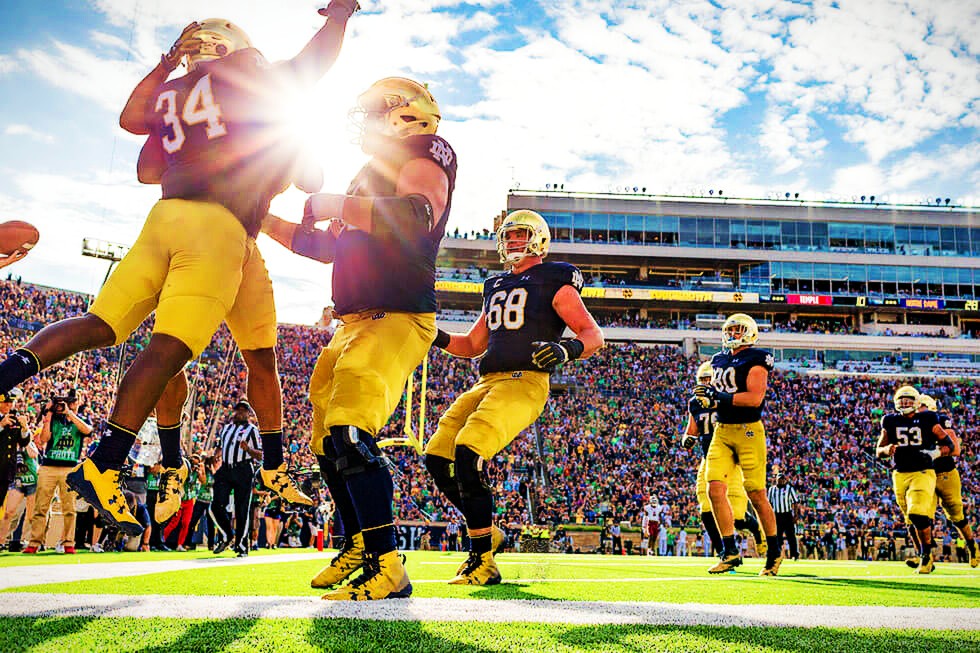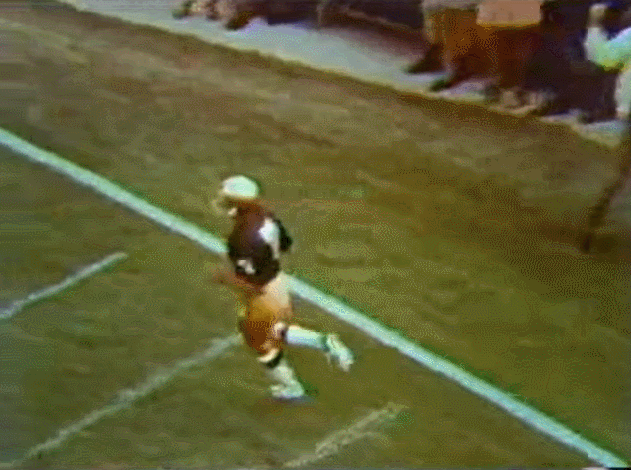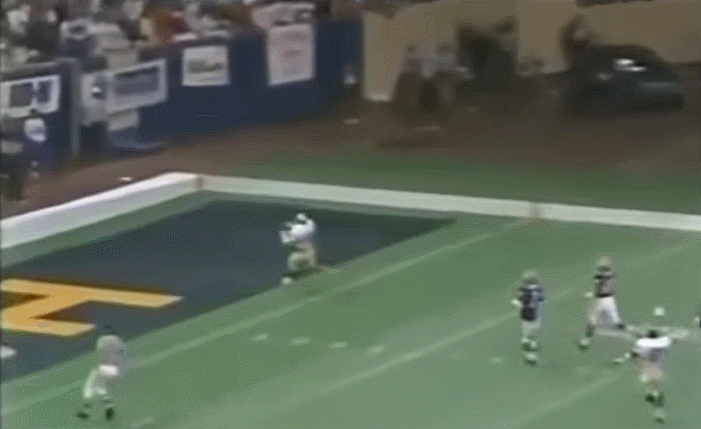A lot of things have changed in football through the years. The ball used to be a different shape. More than 11 players were on the field for each team in the early years. You couldn’t throw the ball forward for a long time. Substitutions were illegal then then legal then back to illegal. Touchdowns used to be worth 5 points. Except for the fact that Michigan football has always sucked, the game of football is practically defined by change.
This includes celebrating after scoring a touchdown. College football has experienced a love and hate–but mostly hate–relationship with celebrating. According to the current rule book…
Pointing your finger or the ball at an opponent, gesturing to slash your throat, taunting or ridiculing your opponent, inciting your opponent or spectators, delayed or excessively prolonged celebration that focuses too much attention upon yourself, high-stepping, removing your helmet, punching your chest, bowing at the waist, throwing, kicking, spiking, or kicking the ball.
…is all technically illegal.
Celebrating is definitely part of the culture now and has been for several decades. And yet, college football has largely treated it as a plague to be cured. First, after the Miami Hurricanes 46-3 thrashing of Texas in the 1991 Cotton Bowl–a game that featured 9 unsportsmanlike flags and 202 total penalty yards from the Canes–college football created the “Miami Rule” the following season which broadened the rules on taunting.
Twenty years later, the NCAA decided on even more drastic measures for excessive celebrations. Meanwhile, the NFL relaxed their policies for the 2017 season and it evidently hasn’t eroded the foundation of the professional game.
After years of watching old games, I’ve always chuckled at how you can see the art of celebrations evolving through time. Today, we’ll take a look at the progress of Notre Dame touchdown joy. For the modern times I tried to stick with repeated celebrations, so no Golden Tate Band Jump today sadly.
1924 – The Ol’ Skip & Turn
Here’s a shot of one of the Four Horsemen casually scoring a touchdown on the way to the school’s first National Championship.
These were innocent times. The player stoically crosses the goal line in shades of embarrassment for humbling his opponent in such a breezy fashion. All that is needed is a little skip ‘n turn back to the field of play. Notice the behavior of the end zone official. He cares not for immediately snatching the football out of the hands of the player.
1935 – The Pile On
This is the scene from Notre Dame’s historic upset of Ohio State in one of the many “Game of the Century” contests from the past. The late comeback win is featured in this clip mere seconds after Wayne Millner’s game-winning touchdown catch.
This is still the olden days where players didn’t know how to react joyfully in a respectful manner. That’s why the default reaction is similar to how you’d rough house with your children. Pile on, boys!
1954 – The Subtle Fist Pump
The times weren’t a’changin’ quite yet. Here’s a video from a 1954 home game featuring quarterback Ralph Guglielmi after he scores on a keeper play.
Do I detect the most subtle of fist pumps with his left hand? Watch closely. The era of personal expression after a touchdown is being born.
1964 – Cheerleader Mob
Things have changed over the years and especially since the latest stadium renovation. Back in the day when part of the band and loads of fans sat at field level in the end zones it was common for players to be congratulated after scoring a touchdown.
Here’s a clip from a long Jack Snow touchdown in 1964 where he blew by the entire defense. He’s met in the end zone by male cheerleaders while the leprechaun comes in late for a quick touch of Notre Dame’s star receiver.
1970 – The Flick & Hug
I don’t know when it happened but according to the rule book the football must be given directly to the referee or placed on the ground after scoring a touchdown. Here’s Joe Theismann scoring in 1970 and tossing the ball to the official in the end zone.
I contend that the humble football player giving the football to the officials made the referees drunk with power. This would eventually lead to the current days where it’s common to see an official chasing after a player to grab the football away so as to avoid civilization collapsing before our very eyes.
1977 – We’ve Found Our Arms
This is the weirdest thing about football. The game was played for 100 years and not until the 1970’s did you see players shoot their arms up in celebration on a regular basis. Seriously, maybe it was something about the counter culture but it took that long for football players to use their arms in such a joyous manner. And even utilize more jumping with arms raised!
This is a shot of legendary Irish tight end Ken MacAfee scoring against Purdue and feeling the freedom of outstretched arms.
1989 – And We Pray
The late 1980’s and early 1990’s was a bit of a wild west situation for celebrating culminating in the aforementioned Miami Hurricanes teams who clashed so fiercely with Notre Dame.
During the Lou Holtz era it was common from skill players like Ricky Watters (above) and Rocket Ismail to take a knee after scoring, and sometimes crossing themselves too.
1991 – Pew Pew Pew
Technically, this was the season after the NCAA clamped down on unsportsmanlike celebrations. However, not only was Jerome Bettis intimidating for defenders, he also scared the officials too. Don’t pull a flag on The Bus!
But seriously, this does point out how inconsistent the flags have been throughout the history of college football. Lake Dawson #87 has his helmet off that’s probably a penalty, too!
1999 – The High Step
Thanks to players like Deion Sanders nearly everyone who scored a touchdown in the 1990’s and into the 2000’s attempted to high step when the opportunity presented itself. To be fair, it does look and feel awfully good to do in the face of your opponent.
Throughout his career, Irish running back Autry Denson loved to break out the high step. When you score 46 touchdowns in your career you tend to find a go-to move.
2005 – Up Top, Bro
Most of the late 1990’s and beginning of the new century was a wasteland of offensive football at Notre Dame. Not only was the passing explosion of the Weis era a sight for sore eyes but this iconic celebration between Jeff Samardzija and Maurice Stovall should leave warm feelings for all who watched these two combine for 26 touchdowns in 2005.
This was just so great. Both receivers were tall and always committed fully to the celebration, including jumping with their legs spread out for full effect.
2009 – Shhhhh
The crowd shush is one of the more mysterious celebrations in college football and sports altogether. At times, it’s completely innocuous and barely noticed. Other times, it leaves people confused (as when Ian Book went to this after his game-winning touchdown run against Virginia Tech).
Then, there are times when it’s used viciously against the opponent crowd and you get a flag pulled on you. So it happened in 2009 against Armando Allen at the Big House.
2018 – Peace
We’re still in a weird place for touchdown celebrations with a confusing rule book and lack of freedom that has seen touchdowns taken away for doing things in an unsportsmanlike fashion. One of the best celebrations in recent years for Notre Dame has been Dexter Williams’ peace sign on his numerous long touchdown runs in 2018.
This one definitely tows the line according to the rule book, especially since Williams’ allegedly turns his hand down at the end to mock Southern Cal’s “V for Victory” sign. Dexter called his shot though, the Irish gained the lead here for the first time in the game and never gave it up.

















ND’s celebrations are/were pretty tame compared to some schools and the pros.
The Stovall-Samardzija celebration is just too perfect and too representative of that high-flying offense to not be the best of my lifetime. I also agree that refs police these celebrations wayyy too much, trying to stomp out the whole “Horns Down” fad is just pathetic.
The Justin Yoon bow after field goals is my favorite of the past few years, but man seeing Dex leave defenders behind and throw up the deuce was also exhilarating.
I’ll be the harmupher’s advocate here and say I like the celebrations where they’re at. It’s fun to see the players try to push that line, Dexter was a pro at it.
The NFL changes were fine as far as the touchdowns go, I guess? I don’t need to see 8 players getting involved in a TD when the Raiders cut the Chiefs lead from 28 to 21 though. I get that they’re excited, but when it runs completely counter to the particular time and score of that game, they look foolish.
This is even more the case with turnovers. The whole group picture in the endzone is silly. Congrats you intercepted Jameis, that only happened 29 other times this year.
Harumphing over. Celebrate big when the time is right (like when you take the lead against your hated Southern Cal rival on route to the playoffs), don’t celebrate big when you’re down multiple scores or just had a routine turnover.
The greatest of all time, of course, is Golden Tate into the MSU band